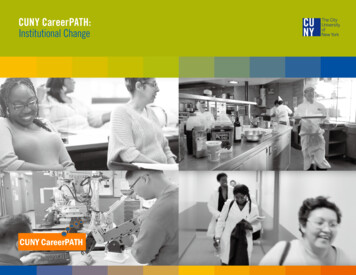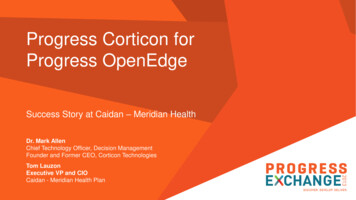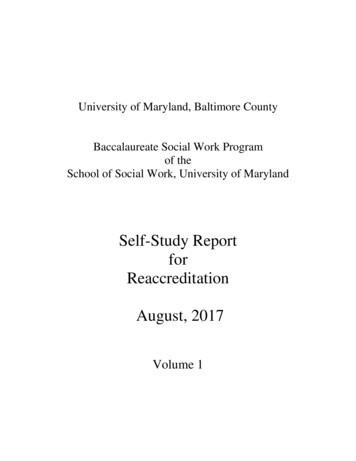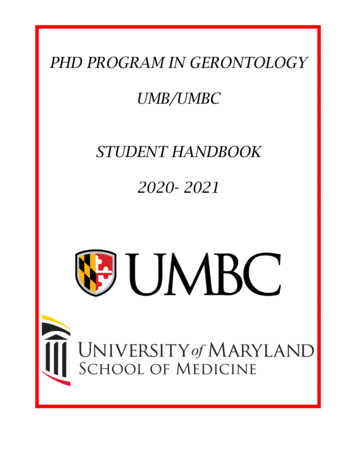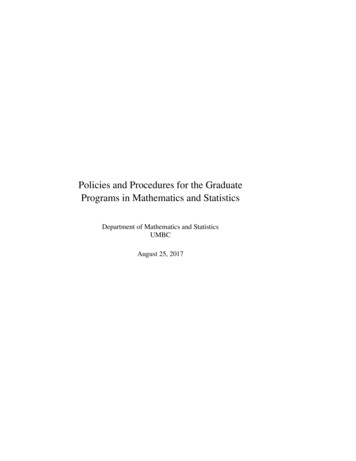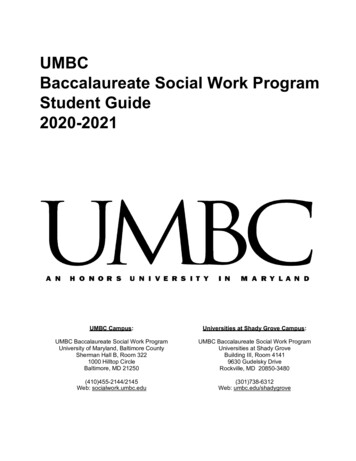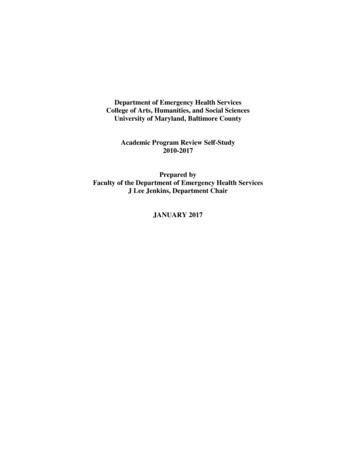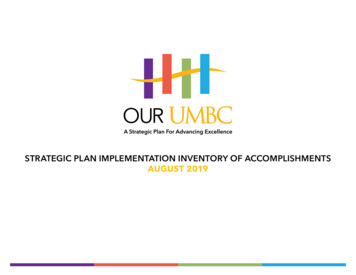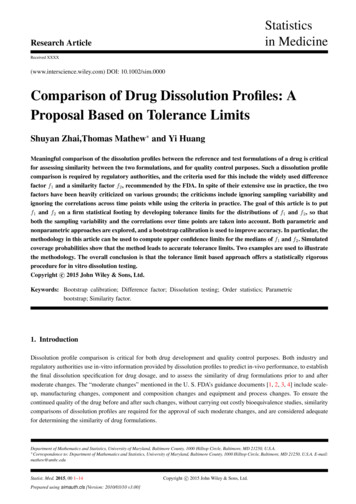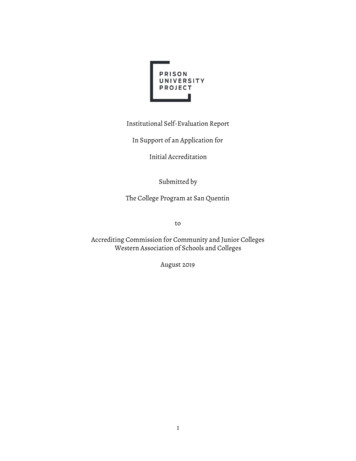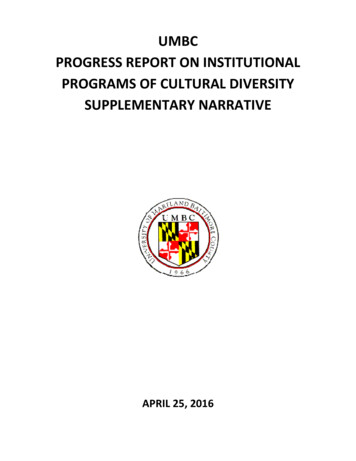
Transcription
UMBCPROGRESS REPORT ON INSTITUTIONALPROGRAMS OF CULTURAL DIVERSITYSUPPLEMENTARY NARRATIVEAPRIL 25, 2016
Report on Institutional Programs of Cultural DiversityTable 1 –Goals, Timelines and Implementation StrategiesThroughout 2015-2016, UMBC has taken steps to continue deepening its commitment to diversity asone of its core principles guiding the recruitment and retention of faculty, staff, and students. Diversityis defined at UMBC in its fullest scope, embracing not only racial and ethnic groups and individuals whoare or have been underrepresented in higher education, but also including religious affiliation, sexualorientation and gender identity, disability, foreign nationality, non-traditional student status, and otherimportant characteristics.UMBC has achieved national recognition as a model campus for its diversity initiatives, including TheMeyerhoff Scholarship Program, the UMBC ADVANCE program, the PROMISE Alliance, the Center forWomen in Technology, the MARC U *STAR scholars program, and the ACTiVATE Entrepreneurshipprogram. These programs and others reflect the substantive commitment to diversity that UMBCcontinues to fulfill. Four overarching goals constitute the organizing framework for UMBC’s diversityprograms:A.To ensure access to educational and employment opportunities for a diverse student,faculty, and staff communityB.To provide conditions for personal successC.To provide a culture of safety, inclusion, and respectD.To encourage and support individual development and advancementColumn D on the table includes some of UMBC’s key diversity initiatives to advance these broad goals,and column F provides highlights of measurable progress made.The Meyerhoff Scholars Program has been at the forefront of efforts to increase diversity among futureleaders in science, engineering, and related fields. The UMBC Meyerhoff family is now more than 1300strong, with over 1000 alumni across the nation and nearly 300 students enrolled in graduate andprofessional programs. In recent years, the program has sought to increase the number of students fromBaltimore City and Baltimore County Public Schools. Strengthening existing connections and forging newpartnerships is a priority so that high school teachers, counselors, principals and STEM programadministrators are aware of the program’s benefits and success in recruiting, retaining and graduating adiverse population of STEM students who in overwhelming numbers go on to pursue advanced STEMdegrees and enter to nation’s work force. Through efforts this year, we had a record number of AfricanAmericans to attend Meyerhoff Selection Weekends. However, we will continue to work for an increasein the number of students from area school systems, particularly both Baltimore City and BaltimoreCounty.2
Table 2 –Programs that support student diversity and successThe Meyerhoff Scholars Program offers a different emphasis that focuses on highly able students whoaspire to become leading research scientists and engineers. The program is open to people of allbackgrounds committed to increasing the representation of minorities in science and engineering. In aproven formula for success, the program adheres to 13 key components. Where top scholars at otherinstitutions are motivated by competition, Meyerhoff rely on mutual support and continually challengeeach other to do more, creating an environment that amounts to positive peer pressure. Students areencouraged to form study groups for particular classes within their majors, with Meyerhoff students.This close-knit community of like-minded peers is a foundational pillar of the program model.The Meyerhoff Graduate Fellows Program was established in 1996 with an MBRS-IMSD (MinorityBiomedical Research Support – Initiative for Maximizing Student Development) grant from the NationalInstitute of General Medical Sciences. The program is open to all U.S. citizens and permanent residentswho are interested in improving the underrepresentation of minorities in STEM. The MeyerhoffGraduate Fellows Program has transformed graduate education at UMBC. Since the program’sinception in 1996, enrollment of underrepresented students in participating PhD programs (BiologicalSciences, Chemistry and Biochemistry, Engineering, Human Services Psychology and Physics) hasincreased significantly. The Under-represented enrollment in the Meyerhoff Graduate Fellows Programhas grown from five students in 1996 to 81 students at present and has recently expanded to includethe Graduate Programs in Life Sciences (GPILS) and Pharmaceutical Sciences at the University ofMaryland, Baltimore. An additional 83 Meyerhoff Fellows have received Ph.D. degrees. By comparison,only seven Under-represented Minorities earned Science, Engineering and Mathematics Ph.D.s inparticipating Ph.D. programs in the 19 years preceding the Meyerhoff Graduate Program.Components of our program will enable UR graduate students to compete more effectively for federalresearch grants, make informed postdoctoral choices, and more confidently pursue leadership positionsin industry, government, and academics. 1Meyerhoff Bridge Program’s Financial Aid Presentation – The Meyerhoff Scholars undergraduateprogram strives to increase diversity among future leaders in science and engineering. UMBC’sMeyerhoff Scholars begin their studies in a summer Bridge program and therefore do not participate inthe traditional Orientation Program for new students. A Financial Aid Workshop is built into thesummer Bridge agenda, ensuring students receive a thorough explanation of their aid and billingexpectations. The group participates in a computer lab and the presentation approach is hands-on,allowing students to use tools such as the Cost Calculator and to complete a website scavenger huntquiz reiterating the key topics students need to know.The Reception and Overnight for Academically Talented African American Students targets highachieving African American high school sophomores and juniors. The students and their families areinvited to a reception to learn about UMBC and meet members of our community. The program1Table 2. Items 27-283
includes remarks by the UMBC President, key faculty and administrators, as well as African Americanstudents. 2The Reception and Overnight for Academically Talented Hispanic/Latino Students targets highachieving Hispanic and Latino high school sophomores and juniors. The students and their families areinvited to a reception to learn about UMBC and meet members of our community. The programincludes remarks by the UMBC President, key faculty and administrators, as well as Hispanic and Latinostudents. Following the reception, student attendees are hosted by members of the Hispanic and LatinoStudent Union (HLSU) in spending the evening to gain a greater understanding of the campuscommunity. 3High School College Nights-UMBC staff provide Financial Aid Night presentations to various area highschools, including schools with vulnerable populations of students including Centennial High School,Chesapeake Science Point Public Charter School, and Long Reach High School. The presentation isgeared to assist students and parents who are considering higher education at any institution andfocuses on foundational aspects of Federal, State, and Institutional financial aid such as types of aidavailable, completing the FAFSA, and applying for additional scholarships.Center for Women in Technology (CWIT)Since its initial creation in 1998, The Center for Women in Technology (CWIT) has developed into a vitalpartner in efforts to increase the retention and recruitment of women and other underrepresentedgroups in the College of Engineering and Information Technology (COEIT). In the past five years, CWIThas focused on building programs and services that: (1) attract more female applicants to our CWITScholars programs and increase the yield of women to COEIT majors, (2) build community amongincreasing numbers of women who are not CWIT Scholarship recipients, and (3) contribute to improvingthe climate in the College for undergraduate women to ultimately increase their retention andgraduation rates.In fall 2015, CWIT served a total of 99 Scholars in three programs - 53 CWIT Scholars, 22 T-SITE (NSF SSTEM funded) and 24 Cyber scholars (funded by the Northrop Grumman Foundation). Sixty-eightpercent of the scholars in all three programs are women. The Cyber and T-SITE scholars programs arefocused on increasing gender as well as ethnic/racial diversity. Fifty percent of Cyber and T-SITE scholarsare women and 21% of Cyber scholars and 25% of T-SITEs are African American or Hispanic. In additionto the Scholars programs, CWIT provides academic, personal, and professional development support toa growing number of CWIT Affiliates and Cyber Affiliates (primarily women; no scholarship support). Thenumber of Affiliates has grown to over 200 students.CWIT has increased its recruitment efforts for scholars by increasing participation in institutionalrecruiting efforts, targeted high school visits, and expanded CWIT recruitment initiatives aimed at highschool girls. During fall 2015, there were 22 high school visits that reached approximately 500 students.CWIT continues to collaborate on the Maryland & Delaware Award for Aspirations in Computing for highschool girls. Aspirations Award applicants are invited to apply for the Bits and Bytes, Cyber 101, and Bestof CWIT recruitment programs. Cyber101 was piloted this year and received 68 applications for 24spaces. In its second year, Best of CWIT attendance increased to 85 students from approximately 50 lastyear. As a result of these targeted recruiting efforts, applications for the CWIT Scholars program23Table 2. Item 16Table 2. Item 154
increased from approximately 75 to 150 over the past five years. Applications from students of colorrose from 13% to 28%. Nine of the 24 offers for the fall 2016 CWIT cohort were made to AfricanAmerican or Hispanic students- up from three last year. The visibility of CWIT scholar programs andboth Affiliates programs has increased in and outside of UMBC as well. 4Women’s CenterThe Women’s Center at UMBC advances gender equity from an intersectional feminist perspectivethrough co-curricular programming, support services, and advocacy for marginalized individuals andcommunities. We prioritize critical social justice as our community value, with a deliberate focus onwomen, gender, anti-racism, and feminism. The Women’s Center addresses recruitment and retentionof underrepresented students, faculty, and staff in various ways to include a scholarship program fornon-traditional women students, identity-based discussion groups for LGBTQ students and women ofcolor. The Women’s Center also provides space for UMBC’s lactation room and seeks to provideadditional support resources to UMBC mothers and parents. 5Off Campus Student Services (OCSS) OCSS focused this year on retention of African American male transfer students. TheCoordinator for Commuter Engagement brought together a focus group of African Americanmales to discuss retention issues at the institution, as well as reformed the student organizationMALES, which focuses on mentoring for African American male transfer students. 6Student Life Student Life staff retreat focused on racial identity development of the staff 7 LGBTQ Campus Climate Workgroup - group that meets monthly to address challenges oncampus for LGBTQ people; this year our big project has been working on creating a system foruse of preferred name 8 Black Unity Meetings for African Student Association, Black Student Union, Caribbean StudentCouncil, and Ethiopian/Eritrean Student Association leaders hosted by Student Life andCommons staff. 9 Staff of Color Network meetings and events hosted by various Student Affairs staff 10Residential Life Participation at Admissions events, particularly Latino/Hispanic and African-American/Blackstudent recruitment events 11 Supporting summer bridge housing for groups such as Upward Bound and Blind Industries 1245Table 2. Item 26Table 2. Items: 10 – 136Table 2. Item 44Table 2. Item 408Table 2. Item 419Table 2. Item 42-E10Table 2. Item 43-E11Table 2. Item 4212Table 2. Item 4375
Discussions in Residential Life Department meeting following critical campus eventsrelated to identity 13Counseling Center We have adopted an online training simulation Kognito - LGBTQ On Campus for Faculty andStaff, that will help build a community of respect, inclusion, and support for LGBTQ students. Inthis 30-minute interactive role-play course, faculty and staff will learn how to addressdiscriminatory language, talk to a student who chooses to discuss their LGBTQ identity, identifywhen a student may be distressed, and refer them to support. LGBTQ on Campus for Studentsteaches users how to respond to biased comments, support a student who comes out, recognizesigns of psychological distress, and connect students to appropriate campus resources. 14 Counseling Center Multicultural Competency Training Program for Interns - Staff and internsneed to develop and maintain multicultural competency. A commitment to working withstudents from a multicultural perspective is particularly important given the diverse studentpopulation and staff at the Counseling Center. The multicultural competency component of thetraining program is designed to develop more intensive and comprehensive knowledge,understanding, and skills in working with students from diverse backgrounds and underrepresented groups. Knowledge of, and sensitivity to, diversity issues are essential in all areas ofpractice and are included in didactic training seminars as well as in supervision, group work, andoutreach programming. As such, participation in the internship training program will not onlyinvolve increasing one’s skills and knowledge base with regard to multicultural competency, butwill also involve some levels of self-disclosure as well as exploration, within the context offurthering personal awareness and professional development. Additionally, interns are expectedto incorporate multicultural perspectives into supervision of practicum students, group therapy,outreach programming, and case conference. 15In addition to the programs noted above that are specifically focused on the needs of some of thespecial populations that enrich our diversity, UMBC offers a wide array of programs to support ourstudent population as a whole, because within that population there is a specific group, AfricanAmerican male transfer students, whose graduation rates have sometimes been lower than those ofWhite students. By targeting such groups as transfer students at UMBC with special support, UMBC isadvancing its goal of supporting a diverse student body.The Transfer Student Alliance (TSA) Program enrolls students at Montgomery College (MC), CommunityCollege of Baltimore County (CCBC), Prince George’s Community College (PGCC), Anne ArundelCommunity College (AACC), and Howard Community College (HCC) who plan to transfer to UMBC aftercompleting an AA degree.Pre-UMBC TSA benefits include: Access to UMBC/UMBC at Universities at Shady Grove facilities and campus services including thelibrary and computer labs Participation in student activities, including cultural and recreational opportunities13Table 2. Item 40-ETable 2. Item 41 – E.15Table 2. Item 40-F146
Concurrent enrollment at a 25% tuition discount for one UMBC course per term (not to exceed atotal of three discounted courses) 50 transfer application fee waiver TSA benefits at UMBC include: Guaranteed transfer admissions to UMBC Guaranteed on-campus housing upon initial matriculation at UMBC’s main campus 1500 merit scholarship for each of two years of full-time study (award can be accepted withother UMBC merit award offers) Priority advising and registration on designated New Student Orientation 16Credit When It’s Due (CWID) - Reverse Awarding of the Associate’s Degree Program aims to assistcommunity college transfer students who have matriculated at UMBC prior to earning their associate’sdegree. Eligible students use coursework they are completing for UMBC bachelor’s degrees towardsremaining requirements needed to complete associate’s degrees at their former community colleges.Leveraging MOU agreements and active partnerships with Montgomery College, Community College ofBaltimore County, Howard Community College, and Anne Arundel Community – the CWID programstrategically targets hundreds of eligible students from diverse backgrounds each semester includingthose of Latino, Asian, Black or African American, and Multi-Racial descent. According to analyticalreports on students completing associate’s degrees through UMBC’s CWID reverse awarding process –students from each of these ethnic or racial categories have been recorded. To date, over 200 studentshave earned associate’s degrees from community colleges throughout the state of Maryland throughthe CWID program. 17The Baltimore County Collegiate Alliance Partnership (CAP) aims to support and promote collegeenrollment with students at Baltimore County Public Schools with the lowest college-going rates byaddressing four key indicators for college enrollment and success: 1) remediation, 2) applying to two ormore colleges, 3) completing and submitting a Free Application for Federal Student Aid (FAFSA), and 4)matriculating in college. To achieve this goal and facilitate these outcomes, the partnership, representedby designated leadership from Baltimore County Public Schools, Community College of Baltimore Countyand University of Maryland, Baltimore County agrees to: Designate a representative(s) for the partnership that offers experience and expertise inrelevant areas including, but not limited to, academic planning and preparation, collegecounseling, and college student success and degree completion.Meet regularly – no less than twice a year – to discuss and better understand the needs andchallenges, to develop strategies and to monitor progress.Leverage existing resources, where possible, and explore opportunities for new resources i.e.grants, to support and advance the work of the partnership.Actively promote the efforts of the partnership with students, parents, faculty, staff, alumni andcommunity leaders.16Table 2. Item: 1417Table 2. Item 197
Provide expertise and resources in the design, development and delivery of relevant contentincluding, but not limited to, academic planning and preparation, college admissions andapplication process, financing college education and student success strategies.Additionally, UMBC waives the 50 admission application fee for participating studentspromotes scholarship opportunities to incentivize completion of the associate’s degree. 18The New Student Orientation program is mandatory for all new freshmen and transfer degree-seekingstudents prior to the fall and spring semesters. New Student Orientation is a day-long event designed toprovide students with information necessary to begin their academic career at UMBC.During orientation, students will learn more about academic requirements, meet with an academicadvisor and register for classes. Orientation includes sessions designed to give students an introductionto the values of UMBC and life outside the classroom. New Student Orientation continues with WelcomeWeek, a week-long series of social and educational events.In addition, a family orientation program is offered for family members who want to learn more aboutUMBC, as they too become part of the university community. During the program, families learn moreabout the activities and opportunities available to students at and around UMBC. 19Financial Aid Night for Building STEPS -Building Science Technology and Education Partnerships, Inc. is anot-for-profit program which supplements student classroom learning and exposes underserved highschool students to science and technology based career fields where minoriti
Graduate Fellows Program has transformed graduate education at UMBC. Since the program’s inception in 1996, enrollment of underrepresented students in participating PhD programs (Biological Sciences, Chemistry and B
